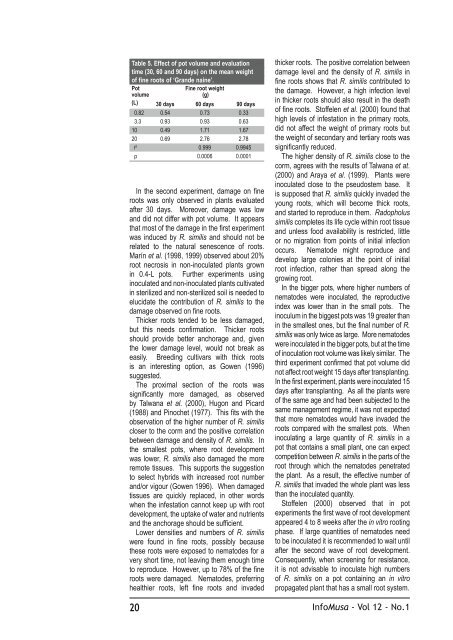Château-Musa - Bioversity International
Château-Musa - Bioversity International
Château-Musa - Bioversity International
Create successful ePaper yourself
Turn your PDF publications into a flip-book with our unique Google optimized e-Paper software.
Table 5. Effect of pot volume and evaluation<br />
time (30, 60 and 90 days) on the mean weight<br />
of fine roots of ‘Grande naine’.<br />
Pot Fine root weight<br />
volume (g)<br />
(L) 30 days 60 days 90 days<br />
0.82 0.54 0.73 0.33<br />
3.3 0.93 0.93 0.63<br />
10 0.49 1.71 1.67<br />
20 0.69 2.76 2.78<br />
r 2 0.999 0.9945<br />
p 0.0006 0.0001<br />
In the second experiment, damage on fine<br />
roots was only observed in plants evaluated<br />
after 30 days. Moreover, damage was low<br />
and did not differ with pot volume. It appears<br />
that most of the damage in the first experiment<br />
was induced by R. similis and should not be<br />
related to the natural senescence of roots.<br />
Marín et al. (1998, 1999) observed about 20%<br />
root necrosis in non-inoculated plants grown<br />
in 0.4-L pots. Further experiments using<br />
inoculated and non-inoculated plants cultivated<br />
in sterilized and non-sterilized soil is needed to<br />
elucidate the contribution of R. similis to the<br />
damage observed on fine roots.<br />
Thicker roots tended to be less damaged,<br />
but this needs confirmation. Thicker roots<br />
should provide better anchorage and, given<br />
the lower damage level, would not break as<br />
easily. Breeding cultivars with thick roots<br />
is an interesting option, as Gowen (1996)<br />
suggested.<br />
The proximal section of the roots was<br />
significantly more damaged, as observed<br />
by Talwana et al. (2000), Hugon and Picard<br />
(1988) and Pinochet (1977). This fits with the<br />
observation of the higher number of R. similis<br />
closer to the corm and the positive correlation<br />
between damage and density of R. similis. In<br />
the smallest pots, where root development<br />
was lower, R. similis also damaged the more<br />
remote tissues. This supports the suggestion<br />
to select hybrids with increased root number<br />
and/or vigour (Gowen 1996). When damaged<br />
tissues are quickly replaced, in other words<br />
when the infestation cannot keep up with root<br />
development, the uptake of water and nutrients<br />
and the anchorage should be sufficient.<br />
Lower densities and numbers of R. similis<br />
were found in fine roots, possibly because<br />
these roots were exposed to nematodes for a<br />
very short time, not leaving them enough time<br />
to reproduce. However, up to 78% of the fine<br />
roots were damaged. Nematodes, preferring<br />
healthier roots, left fine roots and invaded<br />
20<br />
thicker roots. The positive correlation between<br />
damage level and the density of R. similis in<br />
fine roots shows that R. similis contributed to<br />
the damage. However, a high infection level<br />
in thicker roots should also result in the death<br />
of fine roots. Stoffelen et al. (2000) found that<br />
high levels of infestation in the primary roots,<br />
did not affect the weight of primary roots but<br />
the weight of secondary and tertiary roots was<br />
significantly reduced.<br />
The higher density of R. similis close to the<br />
corm, agrees with the results of Talwana et at.<br />
(2000) and Araya et al. (1999). Plants were<br />
inoculated close to the pseudostem base. It<br />
is supposed that R. similis quickly invaded the<br />
young roots, which will become thick roots,<br />
and started to reproduce in them. Radopholus<br />
similis completes its life cycle within root tissue<br />
and unless food availability is restricted, little<br />
or no migration from points of initial infection<br />
occurs. Nematode might reproduce and<br />
develop large colonies at the point of initial<br />
root infection, rather than spread along the<br />
growing root.<br />
In the bigger pots, where higher numbers of<br />
nematodes were inoculated, the reproductive<br />
index was lower than in the small pots. The<br />
inoculum in the biggest pots was 19 greater than<br />
in the smallest ones, but the final number of R.<br />
similis was only twice as large. More nematodes<br />
were inoculated in the bigger pots, but at the time<br />
of inoculation root volume was likely similar. The<br />
third experiment confirmed that pot volume did<br />
not affect root weight 15 days after transplanting.<br />
In the first experiment, plants were inoculated 15<br />
days after transplanting. As all the plants were<br />
of the same age and had been subjected to the<br />
same management regime, it was not expected<br />
that more nematodes would have invaded the<br />
roots compared with the smallest pots. When<br />
inoculating a large quantity of R. similis in a<br />
pot that contains a small plant, one can expect<br />
competition between R. similis in the parts of the<br />
root through which the nematodes penetrated<br />
the plant. As a result, the effective number of<br />
R. similis that invaded the whole plant was less<br />
than the inoculated quantity.<br />
Stoffelen (2000) observed that in pot<br />
experiments the first wave of root development<br />
appeared 4 to 8 weeks after the in vitro rooting<br />
phase. If large quantities of nematodes need<br />
to be inoculated it is recommended to wait until<br />
after the second wave of root development.<br />
Consequently, when screening for resistance,<br />
it is not advisable to inoculate high numbers<br />
of R. similis on a pot containing an in vitro<br />
propagated plant that has a small root system.<br />
Info<strong>Musa</strong> - Vol 12 - No.1

















